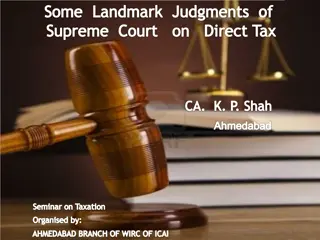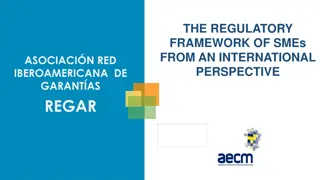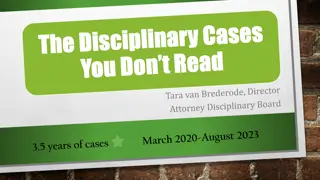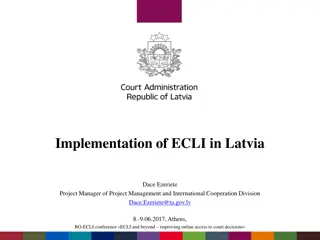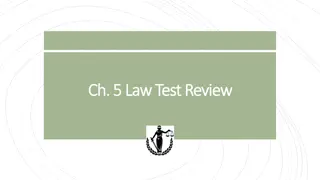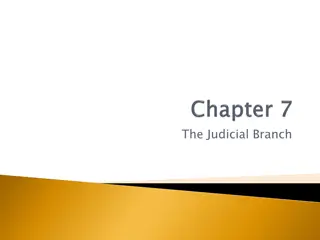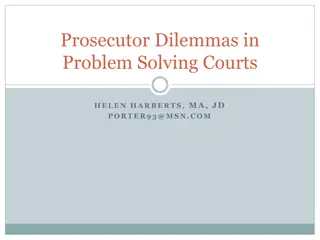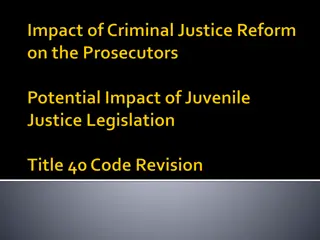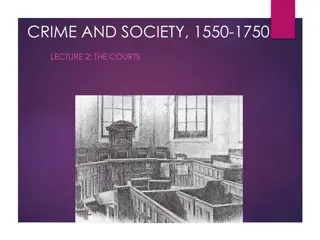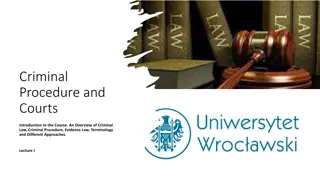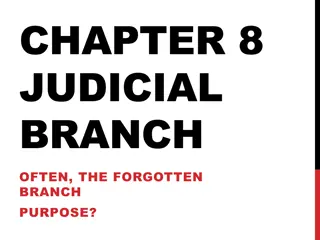Supreme Courts as Guarantee for Effectiveness in the EU: Administration Focus
This study delves into the critical role of supreme courts in ensuring the effectiveness of judicial systems within the European Union. With a focus on the allocation of cases and the length of proceedings, particular attention is given to the management of workload, finances, infrastructure, and human resources to enhance the delivery of justice. Explore insights on case management strategies, timeliness, and the importance of efficient judicial proceedings for upholding the right to a fair trial.
Download Presentation

Please find below an Image/Link to download the presentation.
The content on the website is provided AS IS for your information and personal use only. It may not be sold, licensed, or shared on other websites without obtaining consent from the author.If you encounter any issues during the download, it is possible that the publisher has removed the file from their server.
You are allowed to download the files provided on this website for personal or commercial use, subject to the condition that they are used lawfully. All files are the property of their respective owners.
The content on the website is provided AS IS for your information and personal use only. It may not be sold, licensed, or shared on other websites without obtaining consent from the author.
E N D
Presentation Transcript
SUPREME COURTS AS GUARANTEE FOR EFFECTIVENESS OF JUDICIAL SYSTEMS IN THE EUROPEAN UNION Administration of Supreme Courts: focus on the allocation of cases and length of proceedings Lauranne Claus University of Antwerp Law Faculty
Administration of Supreme Courts: focus on the allocation of cases and length of proceedings
Administration of courts: what? Broad term Management of workloads, finances, infrastructure, HR and communications Report focuses on case management = the effort by the courts to handle cases in such a manner that they are resolved fairly and as promptly and economically as is reasonable in the circumstances of the case Attention for case management grows due to the increasing caseload in many courts 5
Administration of courts: why? Justice delayed is justice denied Timeliness is one aspect of efficiency (one of the parametes of an effective justice system) Timeliness is essential to ensure the smooth functioning of the justice system Art. 6 ECHR: right to a fair trial within a reasonable delay CEPEJ: reasonable time is the lower limit; the goal must be timeliness, judicial proceedings without undue delays 6
How can Supreme Courts manage their case flow? Report focuses on two aspects: Allocation of cases; and Length of proceedings, especially o Timeframes o Statistical data and information to the public o Suppression of procedural abuse o Increased influx of cases 7
Allocation of cases: introductory remarks & survey results
Allocation of cases Proper organisation of the allocation of cases is a necessary requirement for a timely delivery of justice Allocation of cases is closely related to the workload of judges and thus affects the length of proceedings and the efficiency of justice The way in which cases are allocated may thus increases the capacity of the court 9
Allocation of cases ENCJ developed 11 minimum standards for the allocation of cases Allocation should be based on objective pre- established criteria and have to be publicly available Criteria should include the impartiality of the judge, the workload of the judge, the judge s specialism etc. The parties need to be informed about the allocation prior to the hearing / consideration of the case 10
Normative enactment of allocation rules Most Supreme Courts confirmed that the allocation of cases is determined by a normative enactment In a minority of countries there is no internal or external normative enactment that prescribes the allocation rules (NL, LU, SE(A), SE) 11
Criteria used when allocating cases In the majority of countries, the judges specialisation is a criterion that is used to allocate the incoming cases When distributing the cases, most Supreme Courts also indicate to take the workload of the judges into account However, only a minority uses a weighted caseload system 12
Information to the parties At some Supreme Courts parties are informed about which judges the case was allocated to (CZ, EE, IE, IT, LT, SK, ES, LV, RO) In other cases the parties are not informed spontaneously, but they can search for the information themselves (PL, PL(A), HU, PT, PT(A)) In other countries parties are not formally informed (FI, DE, HU, SL, AT(A)) 13
Implement the minimum standards regarding allocation of cases as identified by the ENCJ Not yet fully implemented by all Supreme Courts (e.g. weighted caseload, information to the parties) Best practices: Complexity indicator applied by the Lithuanian Supreme Court Electronic notification system Lexnet of the Spanish Supreme Court 15
Length of proceedings: introductory remarks & survey results
Length of proceedings Scope of the research is limited to: Timeframes Statistical data and information to the public Suppression of procedural abuse Increased influx of cases 17
Timeframes Timeframes set measurable targets (for certain parts of the procedure and / or the procedure as a whole) without which it is not possible to measure and compare case processing delays Timeframes should be clearly measurable, realistic and developed with the support of the stakeholders in order to be effective 18
Timeframes Although timeframes have a positive impact on the length of proceedings, only a minority of the Supreme Courts has introduced the use of timeframes (NL, FI, DE, SE(A), SL, LV) Supreme Administrative Court of Finland: timeframes for the various stages of the proceedings and for the proceedings as a whole Supreme Court of Latvia: targets for the duration of proceedings are set in the civil and criminal department s work plan In addition, only a minority of the Supreme Courts monitor the case s progress consistently and continiously (NL, FI, HU, ES, SL, LV, PT(A), LT) 19
Statistical data & information to the public Providing information on the expected length of a court procedure increases the access to justice and transparency The majority of the Supreme Courts publishes information about the length of proceedings annually, mostly on their website and/or in the annual report (CZ, NL, DE, IT, PL, PL(A), HU, LT, LT(A), ES, AT(A), LV, PT(A)) Some Supreme Courts publish these data more frequently (FI, PL, SL) Other Supreme Courts do not yet publish official data on the average length of proceedings (EE, IE, SK, SE, SE(A), AT, PT) 20
Suppression of procedural abuses The judiciary is not the only player who influences the length of proceedings E.g. parties could stall the proceedings Judges should therefore have a pro-active role in case management Procedural sanctions for causing delay and vexatious behaviour 21
Suppression of procedural abuse Almost all Supreme Courts indicated that they are able to take measures to prevent the abuse of right to trial Measures vary: Conviction to pay the legal costs of the other party Fine Declare belated submissions inadmissable Importance of filter mechanisms! 22
Increased influx of cases Some options: Flexible case assignment system Reallocation of judges CJJE: flexibility is desirable, but the independence of the individual judge has to be respected Reduction of vacancies Restrictions on the right to file a case (filter mechanisms) 23
Increased influx of cases Most Supreme Courts indicated that they do not have many options in case of a significant influx of cases Most used option is adapting the way cases are allocated between the different panels / judges Increased use of the filter mechanism (cfr. suppression of procedural abuse) 24
Implement a system to control the length of proceedings through the use of timeframes and the continuous and real- time monitoring of these timeframes Set up realistic and measurable timeframes for the different kind of cases and the different procedural stages Consult with stakeholders regarding these timeframes Electronic monitoring and early warnings Best practice: Supreme Administrative Court of Finland: differentiated approach + involvement of stakeholders Early warnings in the Hungarian BIIRO programme 26
Publish the agreed timeframes as well as statistics about the length of proceedings per type of case At least once a year, e.g. in the annual report Best practice: Length of proceedings calculator on the website of the Hungarian National Office for the Judiciary Calculator indicates the expected length of proceedings at a given court for a specific type of case 27
Judges have to show pro-active case management Set firm and credible trial dates Use all possible options to expedite proceedings Sanction parties that cause delay or that present vexatious behaviour 28
Provide procedural sanctions for causing delay and vexatious behaviour Different options (e.g. fine, filter mechanisms) 29
Provide a flexible case assignment system, as well as the reallocation of judges as an ultimum remedium Besides the more obvious actions (such as appointing more judges), a flexible case assignment system allows the court to cope better with an increased influx of cases As an ultimum remedium, when other options do not allow the court to cope with the incoming number of cases, the reallocation of judges could be an option (e.g. Curia of Hungary) 30


